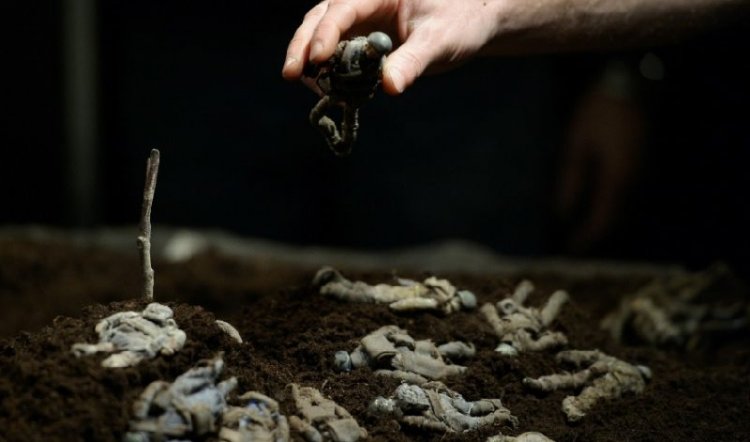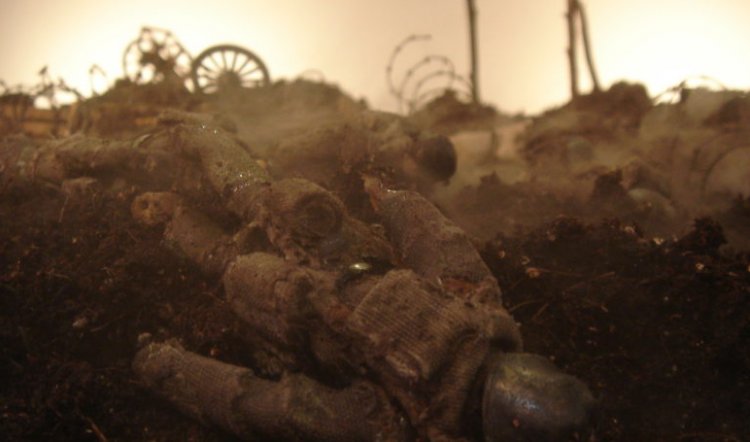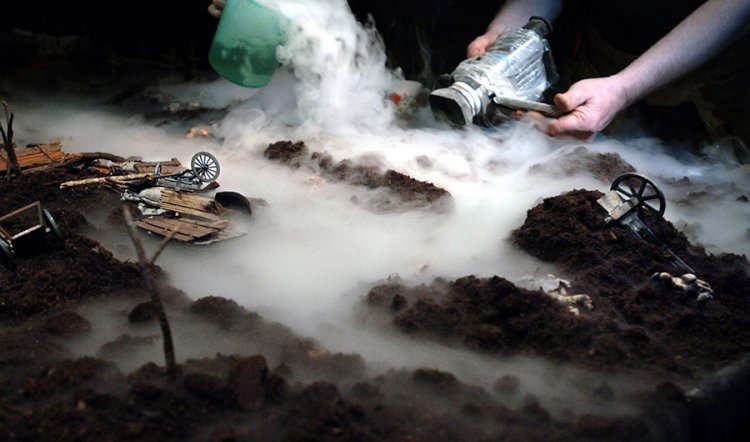
THE GREAT WAR - ADELAIDE
THE GREAT WAR, Hotel Modern & Arthur Sauer at the Adelaide Festival, Dunstan Playhouse, 8-11 March 2018. Photography by Herman Helle
Dutch company Hotel Modern and composer/Foley artist Arthur Sauer have had this show on the road since 2001 which says a lot for its critical and popular success. Nevertheless, The Great War is for some – me included – not only an unusual production but also a curate’s egg.
Continuing a 2018 Festival theme of the 100th anniversary of WW1’s end, The Great War opens, usefully and quite merrily, with a kind of “Dummy’s Guide to How it All Began” and the Dunstan’s stage chockfull of mysterious paraphernalia. To the left Sauer sits surrounded by banks of electronic equipment and FX. A large screen fills the back wall, down front a camera is suspended above a small platform; to the right is a long, waist-high table kind of thing.
On the platform a sheet of paper is laid by one of the team, on it is a drawing of a quaint old Nokia phone, it’s crossed out. Nevertheless, a phone rings in the auditorium later in the evening. A map of Europe is rolled out and the show begins. While one member of the team narrates, the other two place, move and replace on the map figurines representing the players in the sorry tale of Archduke Ferdinand and his unfortunate experiences in Sarajevo with an incompetent but lucky mob of would-be assassins.

With the context established, Sauer and puppeteer/narrators Herman Helle, Pauline Kalker and Arlene Hoorweg move on to the war itself. The text is based on interviews with veterans and diaries and letters from the front, in particular, letters home to his mum from one young French soldier. His matter-of-fact descriptions of the hideous conditions and sights of the trenches are as youthfully heedless as his snippy complaints to his maman: she sent him fruit and didn’t pack it properly: tsk!
As one voice – reading from a script – “acts” the material, the other two move model soldiers, tanks, weaponry and items of scenery around on the tables; hand-held cameras capture the action. These turn out to be soil-filled bases for the kinds of tableaux on display at the War Memorial in Canberra – battlefields, trenches, ruined landscapes, ruined farmhouses – and all the while a pair of legs in army boots trudges through the mud and corpses as the stories are related.
The viewer is constantly torn between the big screen and seeing it real – that is, as a movie – and watching the two human manipulators do their omniscient thing with the models. Meanwhile at his banks of sound gadgetry Sauer contributes the squelching sound of boots in blood and mud, the rat-tat-tat of a heavy machine gun, the unearthly shrieks of metal on metal – and so on.

The mood of the piece teeters back and forth between ungodly and whimsical, heartfelt and jocular. When a forest, and presumably the soldiers hidden in it, are attacked by flamethrowers (cans of WD-40 are sprayed and lit, apparently) the imagined horror is weirdly undercut by the forest actually been made of fresh parsley.
Similarly odd in its effect is some of the narration: heavily-accented Dutch into English, not distinctly amplified and therefore sometimes difficult to understand. And acted badly and with gusto. Letters don’t lend themselves to histrionic reading aloud and definitely not with all the vehemence of a soapie. It detracts from whatever content, pathos or emotion might have been present and tends to make one’s teeth ache.
The Great War has apparently “enjoyed worldwide acclaim” and many in the audience were clearly moved and delighted by it. It lost me entirely when the trenches were briefly abandoned for a tank of murky water. On it floated a model ship and, beneath the surface, a model submarine. Whereas the action on the blasted heaths of the battlefields had some poignancy as the tiny figures were smashed and lost to the mud and ruination, the ship and U-boat looked like a clunky old Japanese animation movie – kitsch rather than cruel; silly rather than sad.



